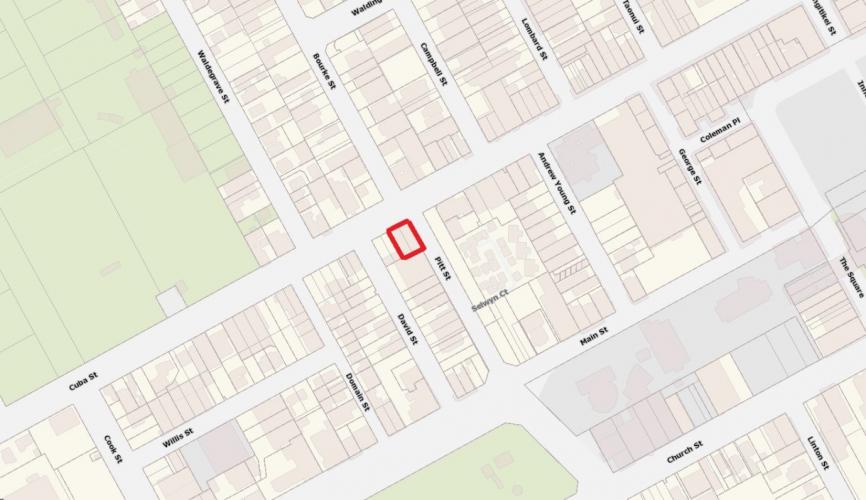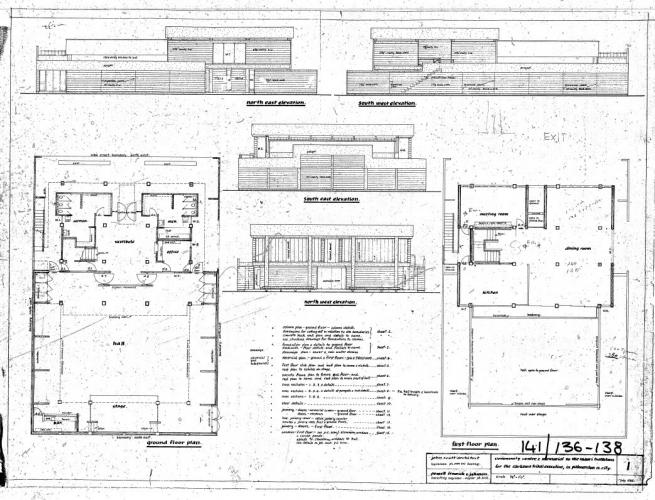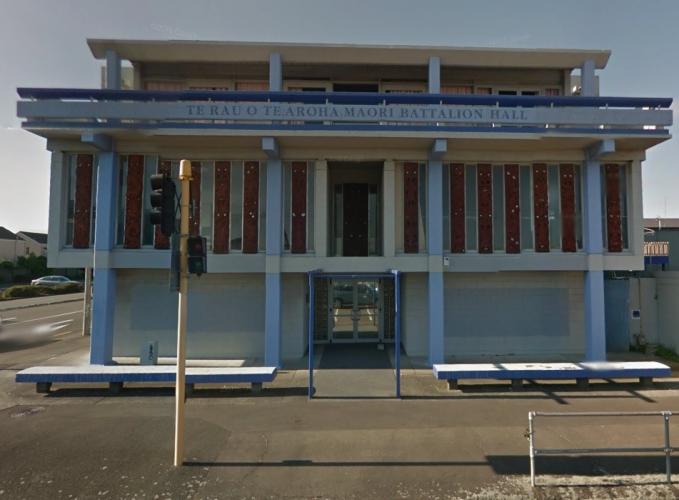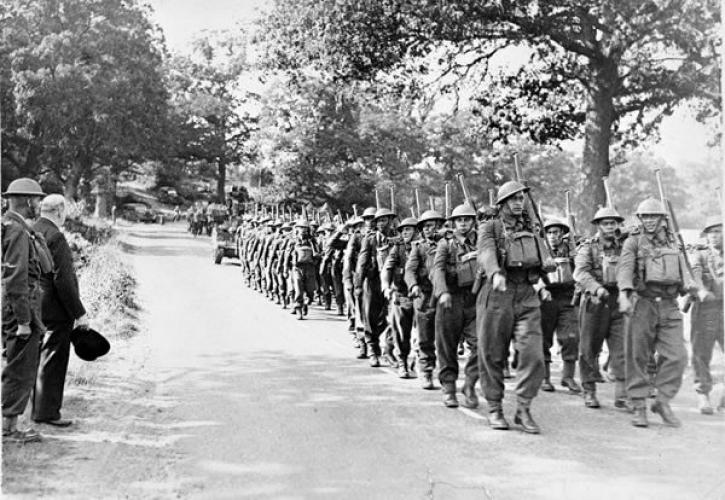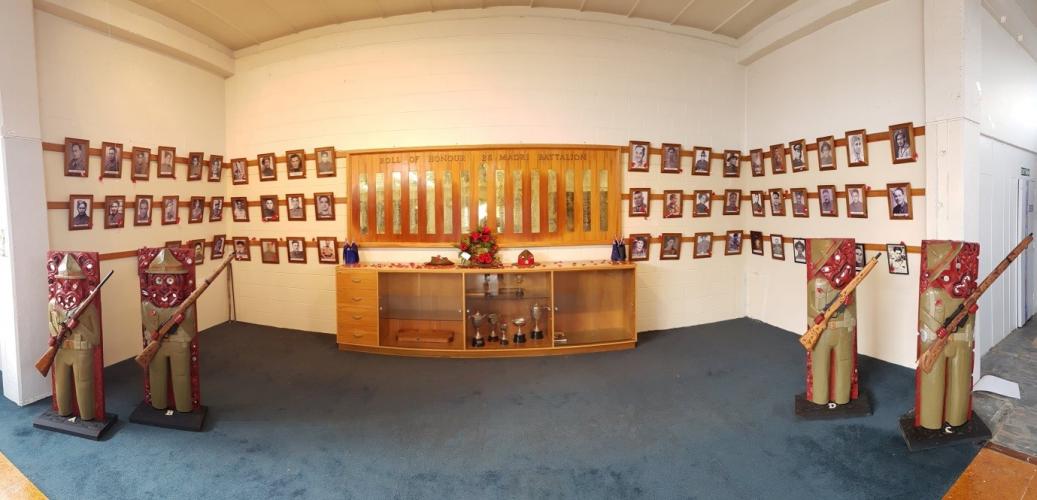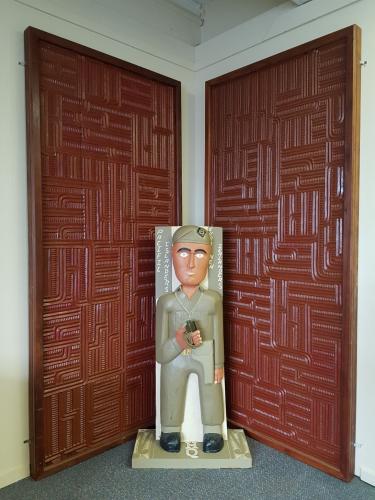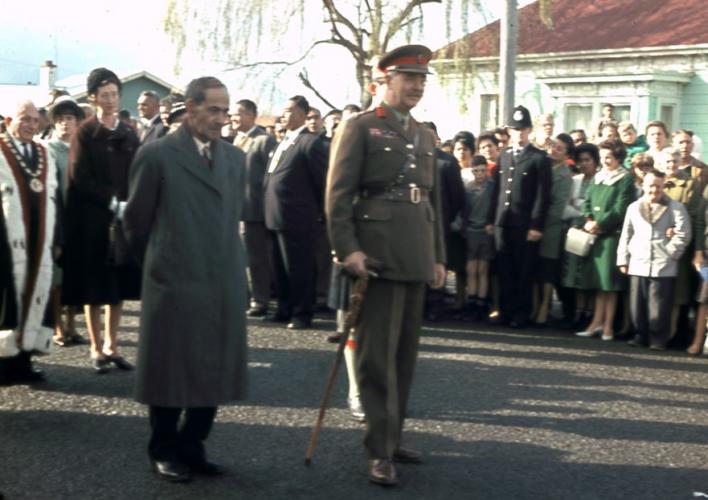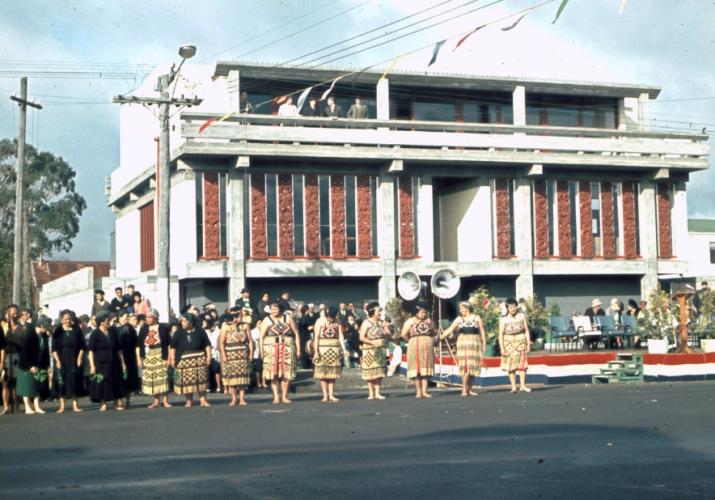123 Maori Battalion Hall Palmerston North, street scene 2018
Reason for the name
This hall in Cuba Street is dedicated to the 28th (Maori) Battalion of 2NZEF in WW2. The 28th Māori Battalion Hall lies on the corner of Cuba Street and Pitt Street. It is a fitting site as it is cited across the road from the Showgrounds area which acted as a military training camp for 28th Māori Battalion men from World War II, as well as lying along the march-out route from the Showgrounds to The Square. Related amenities in the area include The Soldier’s Club further west on Cuba Street and the Cenotaph in The Square.
The Māori Battalion Hall, named 'Te Rau o te Aroha' (emblem of gratitude), was erected in Palmerston North as a memorial to the men who served with 28th Māori Battalion. Originally planned to serve as accommodation for Māori who had to come to the Palmerston North Hospital, the hall later served as a Community Facility for the people of Ngāti Raukawa, Rangitāne and Maūapoko.
The hall was designed by John Scott, architect of Hastings, and the 14 carved panels on the facade (8 feet x 1 foot 6 inches) were carved by Calvin Joseph Te Whetumarama Kereama of Feilding. The carvings are unique as they represent the individual tribal areas from which men were recruited from around Aotearoa as the 28th Māori Battalion was the only nationally recruited unit.
Inside 639 names of those who did not return are inscribed on 14 brass plates. On display are photographs of men from Ngāti Raukawa, Rangitāne and Maūapoko who served with 28 Battalion. All the concrete, both inside and out, was left unplastered and with the marks of the boxing to symbolise the strength of the Māori people. The three-storey building was planned as a community centre to serve all races and was opened in June 1964 by the Governor General, Sir Bernard Fergusson.
The 28th Māori Battalion Hall lies on the corner of Cuba Street and Pitt Street. It is a fitting site as it is cited across the road from the Showgrounds area which acted as a military training camp for 28th Māori Battalion men from World War II, as well as lying along the march-out route from the Showgrounds to The Square. Related amenities in the area include The Soldier’s Club further west on Cuba Street and the Cenotaph in The Square.
Author: Evan Greensides, Heritage Assistant for Palmerston North City Libraries & Community Services.
After the declaration of war in September 1939, Sir Apirana Ngata and other Māori ministers in Parliament pushed for the formation of a Māori battalion which would continue on the tradition of Te Hokowhitu A Tū (the Māori Pioneer Battalion) of WWI. Swiftly granted authorisation for formation, recruitment of soldiers began almost immediately, with the 28th Māori Battalion being formed for service on 26 January 1940 in Palmerston North. Given initial command of the Battalion, Colonel George Dittmer told the men under his command at an early date that, “before we go, we are going to make the community of Palmerston North sorry to see us go”. Dittmer’s assertion was correct as he soon found himself turning down invitations to social functions on behalf of the Battalion. This high regard for the men of the 28th Māori Battalion was also shown by the large farewell Palmerston North treated them to on 2 May 1940, and their enduring legacy through the naming of 9 streets after prominent members of the Battalion in the new Awatapu subdivision in the 1960s.
At the end of World War II war memorials were being considered, and community centres were seen as living memorials for those who had sacrificed for their region. In 1946 the Raukawa Tribal Executive Committee took over the role of the groups War Effort Committee, initially campaigning for a memorial hostel to accommodate Māori visitors to the hospital who were sleeping in cars or on the street. Fundraising began in earnest, with £500 in reserve the committee initially suggesting a contribution of five shillings per member. An initial property on Featherston Street near the hospital was identified as a potential site for the hostel, but a report commissioned into its use concluded that the building on the property was insufficient for purposes.
It wasn’t until six years later that two properties on Cuba Street were cited as the possible location for a memorial hall. The property, owned by W E Jones Limited, was sold to the Raukawa Tribal Executive Committee for £3500. The Committee then engaged John Scott, a prominent Māori architect, to draft a two storey building with a design which would expose the modern architecture and while encompassing Māori culture. To do this, Scott engaged Feilding local Kelly Kareama to carve all 14 panels for the exterior of the building. These panels would depict and would be representative of the style in which of the major iwi across Aotearoa would portray their ancestors. After receiving the initial plans the Executive Committee noted that the features of the building, as well as the building itself, were unique and approved the proposal.
The fundraising for the Māori Battalion Hall took place over many years and in many forms. Most popular were Queen Carnivals, of which there were at least 5 spanning the Manawatu, raising a considerable amount of funds. A well-attended rugby match in 1958 between NZ Māori and Evergreens Rugby also managed to raise £1,230. Adelaide Poananga-Moore being cited as a key player in these endeavours, setting up numerous raffles, bring-and-buy’s and social events. It was through these smaller fundraisers that around £1500 pounds was raised. For her fundraising efforts, as well as vacating one of the houses which originally lay on one the two lots which the Hall was to be built on, Adelaide was named as the hostess in charge of the Hall and given the third storey of the building as her place of residence.
As the Māori Battalion Hall was being erected, the Manawatu Standard provided ongoing coverage of the build. One article from July 1962 noted that the building was:
A worthy memorial to the Māori warriors who trained at their wartime base at the Palmerston North Showgrounds… serv[ing] the present and future generations in many educational and friendly ways.
While building was ongoing, plans for the opening ceremony went ahead, with the initial date being held for 2 May 1964, being the 23rd anniversary of the 28th Māori Battalion’s departure from Palmerston North. This was later pushed back to 30 May, and then, finally, 27 June 1964.
The opening ceremony was a momentous occasion attended by thousands made up of both local attendees and visitors from all over New Zealand. The dawn ceremony to lift the tapu of the building was conducted by Reverend Kuku Tai, senior elder of the Waikato and Ngaruawahia iwi. A dedication was performed by Reverend W R Panapa, Bishop of Aotearoa, with Governor-General Sir Bernard Fergusson officially opening the hall. Also in attendance was Brigadier George Dittmer, commander of the Battalion during World War II, J M Durie, chairman of the Raukawa Māori executive, and Mayor Gilbert Rennie. The ceremony was a bittersweet homecoming for the men of the 28th Māori Battalion – 24 years previous they had been farewelled from the city, but 639 had never returned from foreign battlefields. The opening of the Hall cemented the 28th Māori Battalion’s presence and mana in Palmerston North, allowing those who did not return to have a final resting place in their homeland.


